Definitions for the Amateur Astronomer By Chuck Hawks Every hobby and sport has its own vocabulary and the world of telescopes and astronomy is no different. Here are some brief working definitions/explanations of some of the terms that you will find are frequently used in our--and other peoples--articles. The illustrations below are courtesy of Celestron International. Alt-azimuth (A-Z) mount: 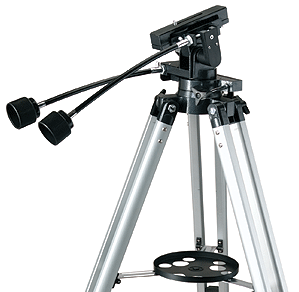 A type of telescope mount that allows the telescope to be aimed up and down (altitude) as well as laterally to the left or right (azimuth). Alt-azimuth mounts are the simplest to set-up and use, but as the earth rotates, adjustments must be made in both elevation and azimuth to keep an object centered in the field of view. (This is because the earth is tilted on its axis.) At high magnification, these adjustments must be made almost continually. The head on a video camera tripod is an example of a typical alt-azimuth mount, as it allows the camera to pan left and right as well as up and down. Apochromatic (APO): An optical system that focuses all three primary colors of light (red, blue and green) to the same point. In telescopes, an apo refractor usually has three elements in its objective lens group, one of which may be made of special, extra low dispersion (ED) optical glass to minimize chromatic aberration or lateral color error (color fringing). Barlow lens:  A Barlow lens is the same thing as a tele-extender for a camera. It is a two to four element lens system that goes between the telescope and the ocular and halves the effective focal length of any ocular with which it is used, thus doubling its magnification. Since there is no free lunch, you also lose 3/4 of the light coming through your telescope. That is a mathematical fact and it is true of any 2x Barlow lens. Binary star: Two stars that revolve around each other (actually, around a common center of gravity), forming their own system. Black hole: The end of a massive star's life. After burning its nuclear fuel it collapses into a neutron star (see "Neutron star"). Because of its mass, the gravitational field of the remaining star core is so great that not even light can escape from its surface. The presence of a black hole can only be detected by its gravitational effect on other objects. Catadioptric (CAT): 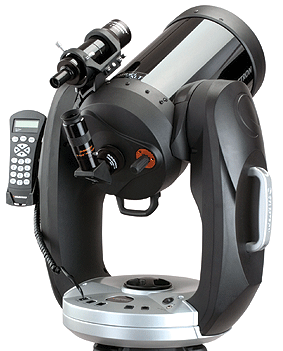 Catadioptric is an optical design using both a lens and mirrors. The most common examples are the Schmidt-Cassegrain telescopes produced by Celestron, Vixen, Meade, and the Maksutov-Cassegrain telescopes produced by Questar, Celestron and Meade. The major advantage of a CAT is that is physically shorter in overall length for a given optical focal length than an all lens (refractor) or all mirror (reflector) telescope. This is because the light path is "folded." (It goes from the front lens to the primary mirror at the bottom of the tube and back to the secondary mirror at the front of the tube to the point of focus at the rear of the telescope.) A CAT will typically be about 1/3 the length of an equivalent focal length refractor or Newtonian reflector telescope and is an excellent choice in a medium to large size amateur telescope. A CAT with an 8" clear aperture is usually shorter and lighter than a 6" Newtonian reflector or a 5" refractor of similar focal length. Chromatic aberration: Color fringing caused by not bringing all three primary colors of light (red, blue and green) into focus at the same point. In telescopes, such color fringing is associated primarily with achromatic (two element) refractors. Also called lateral color error. Clear aperture: The size of the objective lens in a refractor, or the size of the primary mirror minus the obstruction caused by the secondary mirror in a reflector. Clear aperture is very important in an astronomical telescope, because the more light a telescope lets in, the dimmer the object that it can see. A telescope with a 4" clear aperture has about 212 times the light grasp of the human eye. See "Light grasp." Color fringing: See "Chromatic aberration." Coma: An optical aberration that causes points of light (like stars) to appear as little commas. In telescopes, coma is primarily associated with reflector telescopes, where it is typical found toward the edge of the field of view. Declination: The declination movement of a telescope on an equatorial mount corresponds roughly to elevation or altitude on an alt-azimuth mount and is expressed in degrees. Double star: Appears to be a single star to the naked eye, but when viewed through a telescope it can be seen to be two stars in close visual proximity. Double stars may be bound together by gravity in a binary system (see "Binary star"), or simply in the same line of sight as seen from the earth. Ecliptic: The ecliptic is the apparent arc (or path) taken by the sun, moon and planets through the sky. ED: Extra-low dispersion optical glass. Often used for one of the elements in high end, apochromatic refractors. Equatorial (EQ) mount: 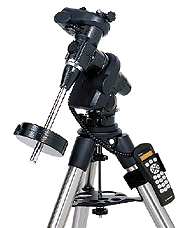 A telescope mount designed to compensate for the rotation of the earth. The common types of EQ mounts are the swing-through fork and the German Equatorial. Fork mounts are usually seen beneath short tube CAT telescopes and are used in conjunction with an angled "wedge" set for the latitude of the observing site. Telescopes in fork mounts can only be balanced in one plane. German Equatorial mounts are used for all types of telescopes and incorporate an internal adjustment used to elevate the mount to the correct angle for the latitude of the viewing site. German Equatorial mounts require counter weights to offset the weight of the scope, but allow the scope/mount to be perfectly balanced in both altitude and azimuth. Erfle: A five element ocular design notable for its wide apparent field of view and generous eye relief. Erfles make excellent low magnification (long focal length) oculars for wide sky views. Exit pupil: The diameter of the pencil of light leaving the ocular of a telescope is called the exit pupil. The exit pupil should not exceed the maximum, dark adapted, diameter of the pupil of the viewer's eye, which is about 7mm for young eyes in good condition. As we age, our maximum pupil size gradually decreases. Middle aged people frequently have about a 5mm maximum pupil size. The elderly are generally down to about 4mm. This sets the minimum practical power for your telescope, which is whatever power produces an exit pupil equal to what your eye can accept. The formula for computing exit pupil size is simple. Divide the clear aperture of the telescope (in millimeters) by the magnification. For example, a 6" (150mm) scope operating at 50 power has a 3mm exit pupil (150/50=3). Eyepiece: See "Ocular." Eye relief: Eye relief is the distance, usually measured in millimeters, from the ocular element to the eye. It is important, because viewing through an ocular with insufficient eye relief (only a few mm) is difficult. Eye relief is particularly important for eyeglass wearers. Fortunately, unless you have astigmatism, it is not necessary to wear your glasses when viewing through a telescope--the telescope itself is focused to your eye. Field of view (apparent and actual): Apparent field of view (AFOV) is the angular size of the light cone covered by the ocular. Good apparent field makes an ocular enjoyable to look through, more like looking through a porthole than a tube. Apparent field is not the same thing as the actual field of view (FOV) of your telescope, which is the angular field of view (the area) visible through your telescope. The true field of view through your telescope probably seldom exceeds 1 degree and is often far less. Actual field of view can be computed by dividing the apparent field of view of your ocular by the power of your telescope/ocular combination. For example, a telescope with a prime focal length of 1000mm, with a 10mm ocular in place, is operating at 100 power (1000/10=100). If that 10mm ocular happened to be a Plossl with an apparent field of 50 degrees, the actual field of view of the telescope would be .5 degree (50/100=0.5). Focal length: The focal length of a telescope is the linear length of the light path from the first active optical element to the point of focus. For example, in a refractor the focal length is measured from the front objective lens to the point of focus at the rear of the optical tube. In a Newtonian reflector, this is from the surface of the primary mirror, to the surface of the secondary mirror, to the point of focus inside the focuser tube that holds the ocular. In a catadioptric telescope like a Schmit-Cassegrain (SCT), it is measured from the corrector plate (front lens), down to the primary mirror, up to the secondary mirror (attached to the center of the corrector plate) and back down through the hole in the center of the primary mirror to the point of focus behind the telescope and in front of the ocular. Focal ratio: Focal ratio is the telescope's photographic "f-stop." It is computed by dividing the focal length (in millimeters) by the clear aperture (in millimeters). Thus, the ubiquitous 8" (200mm) aperture telescope with a focal length of 2000mm has a focal ratio of f/10 (2000/200=10). Focal ratio is not particularly important for visual astronomy, since all telescopes with the same clear aperture capture the same amount of light and focal length, not focal ratio, determines magnification and field of view. For astronomical telescope purposes, f/5 is a "fast" (comparatively short exposure) focal ratio, f/10 is a medium focal ratio, and f/15 is a long (comparatively long exposure) focal ratio. Focal reducer: The opposite of a Barlow lens, a focal reducer typically cuts the prime focal length of a telescope in half for wide sky views, at the expense of magnification. Kellner: The
least expensive ocular design that is worth using. Kellners have three elements
that minimize color fringing and offer decent center sharpness. Edge sharpness
is only so-so and eye relief is limited, as is the apparent field of view. Kellners
are better than modified achromats, but clearly inferior to four element ortho
and Plossl oculars. Celestron used to supply Kellner oculars with their least
expensive telescopes and still may. Light grasp: Usually referenced to the ability of the fully dark-adapted human eye (7mm pupil) to accept light. A telescope with a 4" diameter objective, for example, takes in about 212 times the amount of light the human eye can accept. Thus, its light grasp is 212x. Also see "Clear aperture." Magnification: Magnification is determined by dividing the prime focal length of the telescope (in millimeters) by the focal length of the ocular (in millimeters). In any given telescope, a shorter focal length ocular will give higher magnification and a longer focal length ocular will give lower magnification. Modified achromat (MA): A three element ocular design used by Meade for the oculars they supply with their least expensive telescopes. Some chromatic aberration is apparent when looking at very bright subjects, such as Jupiter or Venus. They have a narrow apparent field of view and limited eye relief, which makes them difficult to look through, especially in the shorter focal lengths. It is best to replace MA's with Ortho, Plossl or other more sophisticated ocular designs. Mount: What the telescope is attached to so that it may be trained and used. "Mount" may be used in reference to just the head used to aim the telescope, or to a head and its associated tripod, base or pier. The types of mounts in common use for amateur telescopes are alt-azimuth and equatorial. See "Alt-azimuth" and "Equatorial." The telescope mount is often overlooked by first time telescope buyers, but it is extremely important. Figure that half of the money you spend for a telescope system should go into the mounting. Nagler: In the late 1970's, TeleVue's Al Nagler formulated a short focal length eyepiece design that essentially incorporated its own Barlow lens and achieved an incredible 82-degree apparent field of view coupled with comfortable eye relief (12mm-19mm, depending on focal length). Nagler oculars are very big and heavy and therefore not appropriate for many small or compact telescopes. (They contain six or seven elements in four or five groups!) Introduced by TeleVue in 1982, Naglers have become the "gold standard" for very short oculars, especially in the 2" diameter mounting barrel size. Neutron star: This is the final stage in the life of most medium size stars. After the star's nuclear fuel is largely exhausted, the star expands, becomes a red giant and then explodes as a supernova. The left over core of the star is supported by neutron pressure. If this core is spinning fast, it may be observed as pulses of visible light, radio waves, or x-rays and is called a "Pulsar." Objective lens: The lens system in the front of a refracting telescope. Usually composed of two, air spaced, optical glass lenses, one made of crown glass and the other of flint glass. This produces an achromatic lens, which can focus two, but not all three, primary colors of light to the same point. Relatively inexpensive refracting telescopes are usually achromats. More sophisticated (and much more expensive) is the apochromatic objective, usually consisting of three air spaced lens elements designed to eliminate lateral color error (color fringing). Ocular: 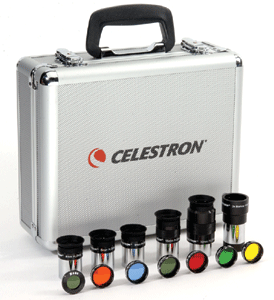 The proper term for "eyepiece." Astronomers and opticians call eyepieces "oculars." Oculars are a self-contained system of magnifying lenses (usually between two and seven elements) that are mounted in a tube and attached in the focal plane of a telescope to magnify the image formed by the telescope. Oculars for astronomical telescopes are interchangeable and commonly come with mounting barrel diameters of .965", 1.25" and 2". There are many different optical formulas for oculars, many of which are named for their designer, such as Kellner, Nagler, Plossl and Erfle. The illustration above is of a Celestron 1.25" ocular set, including carrying case and a set of filters that screw into the bottom of the oculars. Ocular barrel diameter: There are three common ocular barrel diameters. These are .965", 1.25" and 2". 1.25" oculars are the size most often supplied with good quality astronomical telescopes. A few good telescopes are supplied with .96" oculars and conversely, some low quality telescopes are supplied with 1.25" oculars. The folks who distribute cheap telescopes are becoming wise to the fact that 1.25" oculars are a feature semi-informed buyers use to differentiate between "good" and "bad" telescopes and have begun to supply the larger size with their inferior scopes to deceive such buyers. The optical quality of an ocular is much more important than its nominal diameter. Optical tube: The basic telescope, without a mount, finder, eyepieces or accessories. Orthoscopic (Ortho): An ocular design that uses for elements asymmetrically spaced in three groups. Well designed and manufactured Orthos are very sharp, flat field eyepieces and are highly regarded for planetary observation, especially in the shorter focal lengths. Orthos are less subject to internal reflections than Plossls. On the other hand, the 50-degree AFOV of Plossl oculars makes them a better choice for deep sky and all-around viewing. The drawbacks to Orthoscopic eyepieces are a limited AFOV of around 40 to 45-degrees and very limited eye relief. Due to their limited eye relief, Orthos are difficult for eyeglass wearers to use in focal lengths shorter than about 25mm and difficult for everyone in focal lengths shorter than about 10mm, unless you don't mind your eyelashes brushing the ocular lens. Pier: A column that supports a telescope mount (instead of a tripod or other base). Planetary nebula: A misleading term, since there is nothing planetary about these deep sky nebulas, which are in our galaxy, but far from our solar system. Planetary nebula (the Ring Nebula, M-57, is perhaps the most famous) are the glowing gases that mark the remains of a white dwarf star that exhausted its nuclear fuel and blew off its atmosphere in an outward flowing bubble of gas that is the planetary nebula. In the far distant future, our sun will suffer such a fate. Planet: The major bodies orbiting a sun are called planets and comprise a solar system. Earth, for example is a planet in our solar system. The nine planets generally recognized as such are (from the sun outward): Mercury, Venus, Earth, Mars, Jupiter, Saturn, Uranus, Neptune and Pluto. Of these, Pluto is probably not a true planet formed in conjunction with our solar system, but a body captured from deep space by the gravity of our sun. On the other hand, our own earth and moon are actually a binary planet system and should be considered as two planets; the moon is not a captive of the earth's gravity (the definition of a moon), both bodies actually rotate around a common center of gravity in their orbit around the sun. Thus, we are part of a binary planet system. Seen in this light, there are still nine planets circling the sun, but they should be recognized as Mercury, Venus, Earth / Moon, Mars, Jupiter, Saturn, Uranus and Neptune. Plossl: An optical design for eyepieces that is very popular. Celestron, Meade, Orion, Tele Vue, Vixen and others offer high quality Plossl oculars. Plossls are usually very sharp and offer about a 50-degree apparent field of view. This apparent field is wider than an Ortho or a Kellner, but not as wide as an Erfle or Radian. The Plossl optical formula uses four elements in a symmetrical design. Unfortunately, this symmetry makes Plossl oculars susceptible to internal reflections when viewing bright objects at high magnification. Plossls offer excellent sharpness, a flat field and adequate eye relief for eyeglass wearers in focal lengths of about 25mm and longer. Non-eyeglass wearers can usually tolerate Plossls as short as about 10-12mm before their eyelashes start brushing the ocular lens. Plossls are among the best general purpose oculars. Telescope companies such as Celestron, Meade, Orion, Sky View, Tele Vue and Vixen generally supply a Plossl ocular with their better telescope packages. Power-per-inch (ppi):
Calculated by dividing the magnification at which a telescope/ocular
combination is operating by the diameter of its clear aperture in inches. A
perfect telescope in perfect seeing conditions can support about 60 ppi. Many
astronomers use the figure 50 ppi, considering it more reasonable under ideal
conditions. In average, rather than ideal, seeing conditions a maximum
magnification of 25-30 ppi is probably more appropriate. See also "Useless
magnification." Pulsar: See "Neutron star." Radian: A proprietary TeleVue ocular design by Al Nagler with a 60-degree apparent field of view and 20mm eye relief, regardless of focal length. Radian oculars offer full field sharpness with true orthoscopic linearity, high contrast and compact size. They are a good choice for eyeglass wearers. Reflector: 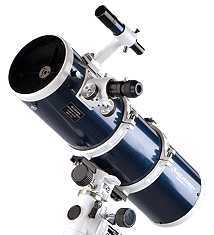 A telescope using only mirrors for its optical elements. The Newtonian reflector is the most common kind, easily identified by its relatively long tube and its focuser/eyepiece located at the top of the tube. Newtonians are the least expensive type of telescope to manufacture and usually allow the most light grasp for the money spent. Next in popularity and commonly used for large, observatory telescopes, is the Cassegrain design. Cassegrain telescopes have their secondary (small) mirror directly in front of and facing the primary (large) mirror into which a hole is cut in the center to allow the focused light to pass through to the focuser/eyepiece, which are at the back of the telescope behind the primary mirror. Cassegrain telescopes are physically shorter than Newtonian telescopes of the same focal length, because their light path is folded upon itself and are a good choice for a portable reflector. Refractor:  A telescope that is made with glass optical elements, like a camera lens. Good refractors are known for their high contrast, sharp images. This makes refractors excellent at resolving fine detail and they are widely preferred for studying the moon and planets. The main drawbacks to refractors are their physical length (the light path is straight through the telescope, not folded at all) and their expense to manufacture. (It is more expensive to grind and polish both sides of a lens than one side of a mirror.) For these reasons, small refractors are very popular, but long focal length refractors with large objective lenses are seldom seen. Amateur astronomers requiring a portable telescope would be wise to consider refractors with objectives between 3" and 5" in diameter. Right Ascension (RA): Right ascension corresponds roughly to the azimuth of an equatorially mounted telescope and is expressed in hours and minutes. Star cluster: A group of stars within a galaxy that move through space together. The number of stars in a cluster can vary widely, from perhaps 100 to 1,000,000. There are two types of clusters, open clusters and globular clusters. The former are usually relatively new stars, numbering 100 to 10,000, that are loosely associated. The Pleiades (Seven Sisters) are an example of a well-known open star cluster. Globular star clusters are tight balls of 10,000 to a million very old stars that orbit the fringe of the galaxy. It has been suggested that they are proto-galaxies than never formed and were captured by the gravity of a large galaxy. Probably the best-known globular cluster visible from the northern hemisphere is M-13 in the constellation Hercules. Star diagonal: 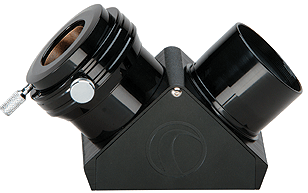 A prism or mirror in a holder that mounts to the back of a telescope and bends the light path 90-degrees. Mirror diagonals transmit almost 100% of the light that enters them and are therefore more efficient (and desirable) than prism diagonals. Star diagonals are used in CAT and refractor telescopes when viewing at high angles of elevation to make it easier for the observer to look through the telescope. Sometimes 45-degree diagonals are used in spotting scopes, but you don't see many 45-degree diagonals on the back of astronomical telescopes. When using a 90-degree star diagonal the image you see is reversed (a mirror image). Like the oculars they are designed to accept, star diagonals come with .96", 1.25" and 2" mounting barrels. Stellar magnitude, apparent: A method of rating or comparing the brightness of different stars as seen from the earth. The reference point is 0.0 (zero) magnitude brightness. A 0.0 magnitude star is 2.51 times brighter than a 2.0 magnitude star and 100 times brighter than a 5.0 magnitude star (2.51 to the fifth power). It is 2.51 times dimmer than a -1.0 magnitude star. Stars below about six magnitude are not visible to the human eye, while a 4" Celestron XLT102ED telescope has a theoretical stellar viewing limit of 12.5 magnitude. Telescope size: Refers to the diameter of the objective or the clear aperture, not the length of the optical tube or the size and weight of the mount. Subjective and not precisely defined, but for our purposes "small telescope" would refer to one with about a 2.4" (60mm) to 4.5" (115mm) diameter clear aperture. Scopes with clear apertures smaller than 60mm simply do not qualify as astronomical telescopes, regardless of how they are sold, and "serious" astronomical telescope objectives start at about 3" (75mm). A "medium telescope" has a clear aperture ranging from approximately 5" (127mm) to 8" (203mm). Any amateur telescope with a clear aperture larger than 8" could reasonably be called a "large telescope" and telescopes much larger than 8", even comparatively compact catadioptric (CAT) designs, are notoriously difficult to transport and set-up. Useless magnification: Magnification beyond what the telescope and seeing conditions can support. Using too much magnification in a telescope results in low contrast, dim and blurry views that reveal less detail than could be seen using less magnification. White dwarf: The final stage in the life of a small star, such as our sun. After the star consumes most of its hydrogen, it expands to become a red giant and then blows off its atmosphere as a bubble of gas (planetary nebula). The star's remaining core becomes a faint white dwarf, supported by electron pressure. A white dwarf can be seen in the center of the Ring Nebula (M-57) in highly detailed photos. |